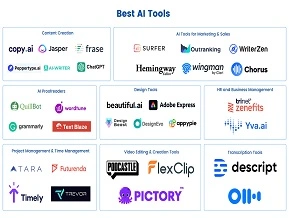Data Analytics in AI: What Every Beginner Needs to Know in 2025?
What is Data Analytics in AI and Why Does It Matter in 2025?
Data analytics in AI refers to the process of examining vast datasets using artificial intelligence techniques to extract meaningful insights, patterns, and trends. This intersection enables machines to learn from data and make intelligent decisions without explicit programming, forming the backbone of modern AI applications.
The Definition of Data Analytics in the Context of AI
At its core, data analytics in AI involves leveraging algorithms and models to process and interpret complex data. These models learn from historical information to predict future outcomes, recognize anomalies, and optimize processes. Unlike traditional analytics, AI-powered data analytics can handle unstructured data like images, text, and videos, making it far more versatile.
Importance of Data Analytics for AI Performance and Decision-Making
The accuracy and effectiveness of AI systems heavily depend on the quality of data analytics. When AI algorithms analyse well-curated and comprehensive datasets, they improve in performance, enabling smarter, faster, and more reliable decision-making. Without robust data analytics, AI models risk producing biased or inaccurate results, which can lead to poor decisions.
How Data Analytics Drives Business and Technological Advancements
Businesses rely on AI for data analytics to gain competitive advantages by uncovering hidden opportunities, automating routine tasks, and enhancing customer experiences. Technological sectors benefit by innovating new products and services, optimizing supply chains, and improving cybersecurity. This fusion accelerates growth and operational efficiency across industries.
The Growing Relevance of Data Analytics with AI in 2025
In 2025, the role of ai for data analytics becomes increasingly crucial as organizations face exponentially growing data volumes and complexity. Advanced AI models enable real-time data processing and predictive insights, empowering businesses to adapt swiftly in dynamic markets. As AI and data analytics evolve hand-in-hand, their combined potential continues to transform industries worldwide.
How Does Data Analytics Work in AI?
Data analytics in AI is a sophisticated process where data is collected, processed, and analysed using artificial intelligence techniques to uncover insights that drive smarter decisions. This process integrates various types of analytics to fully leverage data’s potential in AI systems.
Different Types of Data Analytics Used in AI
AI utilizes several types of data analytics to interpret and act on data effectively:
- Descriptive Analytics explains what has happened by summarizing historical data.
- Diagnostic Analytics investigates why something occurred by finding root causes.
- Predictive Analytics forecasts future outcomes based on patterns in data.
- Prescriptive Analytics recommends actions to optimize results using AI-driven models.
These types work together to provide a comprehensive understanding for AI decision-making.
The Process of Collecting and Preparing Data for AI Analytics
The foundation of AI analytics is high-quality data collection. This involves gathering data from diverse sources such as sensors, databases, social media, and IoT devices. Once collected, data undergoes cleaning, transformation, and integration to ensure accuracy and consistency. Proper preparation is critical because AI models rely heavily on well-structured data for training and evaluation.
Role of Big Data and Real-Time Data Processing
With the explosion of big data, AI systems require tools that can handle massive datasets quickly. Real-time data processing allows AI to analyze streaming data instantly, enabling timely decisions in areas like fraud detection, autonomous vehicles, and personalized marketing. The combination of big data and real-time analytics enhances AI’s responsiveness and accuracy.
How AI Models Analyse Data to Find Patterns and Insights
Once data is prepared, AI models use machine learning and deep learning algorithms to detect patterns, correlations, and anomalies within the data. These models continuously learn and improve their accuracy, allowing businesses to uncover hidden insights and optimize strategies. The growing demand for ai for data analytics solutions highlights how AI transforms raw data into valuable knowledge.
What Role Does AI Play for Data Analytics?
Artificial intelligence plays a transformative role in enhancing data analytics by applying advanced techniques that improve the depth, speed, and accuracy of insights extracted from complex data.
AI Techniques Enhancing Data Analytics
Several AI technologies significantly boost the power of data analytics. Machine learning enables systems to learn patterns from data without explicit programming. Deep learning, a subset of machine learning, excels at analysing large, unstructured datasets like images and audio. Natural Language Processing (NLP) helps machines understand and interpret human language, making sense of text-heavy data sources such as customer feedback or social media. Computer vision allows AI to analyse visual data, unlocking new analytics possibilities in fields like manufacturing and healthcare.
Automation of Data Analysis Tasks Using AI
AI automates many data analytics tasks that were once time-consuming and manual. Data cleaning, anomaly detection, pattern recognition, and even generating reports can now be automated, freeing up human analysts to focus on higher-level interpretation and decision-making. This automation accelerates the analytics lifecycle and reduces human error.
Examples of AI-Powered Data Analytics Applications
AI-driven data analytics is already making significant impacts across industries. In healthcare, AI analyses medical images and patient data to improve diagnosis and treatment plans. In finance, it helps detect fraudulent transactions and forecast market trends. Marketing teams use AI analytics to personalize campaigns and optimize customer targeting based on behaviour insights.
Benefits of AI Integration in Analytics
The integration of AI in data analytics offers clear advantages: faster processing of vast datasets, improved accuracy in predictions, and scalability to handle growing data volumes. By combining human expertise with AI’s computational power, organizations achieve more effective and timely decision-making, driving better outcomes across sectors.
Which Tools and Technologies Are Essential for Data Analytics in AI?
Data analytics in AI relies on a variety of powerful tools and technologies that enable organizations to process, analyse, and visualize large datasets efficiently and effectively.
Popular AI Data Analytics Platforms
Several platforms have become industry standards for AI-driven data analytics. TensorFlow is widely used for building and deploying machine learning models due to its flexibility and scalability. Power BI offers robust data visualization and business intelligence capabilities, making it easier to interpret complex data insights. Apache Spark provides fast, distributed data processing ideal for handling big data workloads in AI analytics projects.
Emerging Tools and Trends in 2025
As technology advances, new tools are shaping the future of AI data analytics. AutoML (Automated Machine Learning) simplifies model building by automating feature selection, model training, and tuning, allowing non-experts to develop effective AI solutions. Explainable AI (XAI) tools are gaining prominence, helping users understand how AI models arrive at decisions, which is crucial for transparency and trust in sensitive applications.
The Role of Cloud Computing in AI Data Analytics
Cloud computing plays a vital role in modern AI data analytics by providing scalable infrastructure and on-demand computing power. Cloud platforms like AWS, Azure, and Google Cloud offer integrated AI services and data storage, enabling businesses to manage massive datasets and run complex analytics without investing heavily in physical hardware.
Importance of Data Visualization and Reporting Tools
Effective data visualization tools are essential for communicating AI analytics insights clearly and compellingly. Tools such as Tableau and Power BI transform raw data into interactive dashboards and reports, facilitating better understanding and faster decision-making for stakeholders.
By leveraging these tools and technologies, organizations can maximize the potential of data analytics in AI to drive innovation and business growth in 2025 and beyond.
How can Beginners Start Learning Data Analytics in AI?
Starting a journey into data analytics in AI can seem overwhelming, but with the right approach and resources, beginners can build a strong foundation and gradually advance their skills.
Essential Skills to Develop
To succeed in AI-driven data analytics, beginners should focus on developing key skills such as statistics, which forms the basis for understanding data patterns and significance. Programming skills, especially in languages like Python or R, are crucial for manipulating data and implementing machine learning algorithms. Learning the basics of machine learning helps understand how AI models work. Additionally, data wrangling — the process of cleaning and transforming raw data — is essential for preparing datasets for analysis.
Recommended Online Courses and Certifications
Many online platforms offer courses tailored for beginners. Websites like Coursera, edX, and Udacity provide comprehensive programs on data analytics and AI fundamentals. For those seeking structured learning paths, certifications from recognized institutions, including offerings by the Learning AI Institute (LAI), are valuable for building credibility and gaining practical knowledge.
Hands-On Projects and Practice Datasets
Applying knowledge through real-world projects is key to mastering data analytics in AI. Beginners should work on hands-on projects involving datasets from sources like Kaggle or UCI Machine Learning Repository. These projects help in understanding data cleaning, model training, and result interpretation, bridging the gap between theory and practice.
Tips for Joining AI and Data Analytics Communities
Networking with peers accelerates learning. Beginners are encouraged to join online forums, social media groups, and local meetups focused on AI and data analytics. Platforms like GitHub, Stack Overflow, and LinkedIn offer excellent opportunities to seek advice, share projects, and stay updated on the latest trends.
Starting with these steps, beginners can confidently build their expertise in data analytics in AI and contribute meaningfully to this growing field.
What Challenges and Ethical Issues Should Beginners Know About in AI for Data Analytics?
As beginners dive into AI for data analytics, understanding the challenges and ethical issues surrounding this field is crucial for responsible and effective practice.
Data Privacy and Security Risks in AI Analytics
One of the primary concerns in AI-driven data analytics is safeguarding sensitive information. AI systems often analyze vast amounts of personal and organizational data, which raises risks related to data breaches, unauthorized access, and misuse. Beginners must be aware of privacy laws like GDPR and implement security best practices to protect data integrity.
Bias and Fairness Problems in AI Models and Datasets
Bias in AI models is a significant ethical issue. When training data contains historical biases or lacks diversity, AI systems can perpetuate or even amplify unfair treatment of certain groups. Beginners should understand how biased datasets impact model fairness and learn techniques to identify and mitigate these biases to promote equitable AI outcomes.
Transparency and Explain ability Challenges in AI Decision-Making
AI models, especially complex ones like deep learning networks, often operate as “black boxes,” making it difficult to understand how decisions are made. This lack of transparency can hinder trust and accountability. Beginners must appreciate the importance of explainable AI tools that provide clear insights into model behaviour and decision logic.
Importance of Ethical AI Practices and Guidelines
Adopting ethical AI principles is essential to ensure AI technologies benefit society without causing harm. This includes respecting privacy, ensuring fairness, maintaining transparency, and being accountable for AI outcomes. Beginners should familiarize themselves with ethical guidelines and frameworks to guide their work in AI for data analytics responsibly.
By recognizing these challenges and ethical considerations, newcomers can contribute to the development of trustworthy and socially responsible AI solutions.
What Future Trends Will Shape Data Analytics in AI Beyond 2025?
The future of data analytics in AI promises to be transformative, driven by cutting-edge technologies and evolving user needs. Several key trends are set to redefine how data is processed, analysed, and utilized.
Advances in AI Algorithms Improving Analytics Accuracy
Continuous improvements in AI algorithms will enhance the precision and reliability of data analytics. Sophisticated machine learning models and deep learning architectures will better capture complex patterns, enabling more accurate predictions and actionable insights across industries.
Increased Use of Edge Computing and IoT Data for Real-Time Analytics
The expansion of Internet of Things (IoT) devices and edge computing will play a pivotal role in real-time data analytics. Processing data closer to the source reduces latency and bandwidth usage, allowing instant insights and faster decision-making, particularly in sectors like manufacturing, healthcare, and smart cities.
Growth of Explainable AI for Better Trust and Adoption
As AI systems become more integral to decision-making, the demand for explainable AI will increase. Tools that clarify how AI models arrive at conclusions will foster transparency, build user trust, and facilitate wider adoption of AI-powered analytics in sensitive areas such as finance and healthcare.
Integration of AI Analytics with Augmented Reality and Other Emerging Tech
Emerging technologies like augmented reality (AR) will increasingly merge with AI analytics, creating immersive data visualization experiences. This integration will enable users to interact with analytics in more intuitive and insightful ways, transforming sectors like retail, education, and remote work.
Together, these trends highlight the evolving landscape where data analytics in AI becomes more accurate, immediate, understandable, and interactive, pushing the boundaries of what organizations can achieve beyond 2025.
Conclusion
The high demand for AI and data analytics skills in the job market makes this an ideal time for beginners to start learning. With diverse career opportunities available across industries, mastering these skills opens doors in sectors like healthcare, finance, and technology. Continuous innovation ensures the field remains dynamic and exciting, offering constant growth and learning. For those looking to get started, LAI’s online courses provide an excellent gateway to mastering AI and data analytics, equipping learners with practical knowledge and tools to succeed in this evolving landscape.












